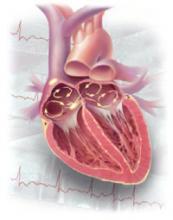- Pursue a rate-control strategy for most patients with atrial fibrillation (AF); rhythm control may be preferable for younger (<65 years) symptomatic patients (A).
- Use a risk stratification scheme to guide decisions regarding anticoagulation therapy; adjusted-dose warfarin is extremely effective at preventing strokes in patients with AF (A).
- Hemodynamically unstable patients require urgent cardioversion, so you should not delay the procedure in order to provide anticoagulation therapy (C).
Strength of recommendation (SOR)
- Good quality patient-oriented evidence
- Inconsistent or limited-quality patient-oriented evidence
- Consensus, usual practice, opinion, disease-oriented evidence, case series
Atrial fibrillation (AF), the most common arrhythmia seen in clinical practice, affects an estimated 2.2 million American adults.1 The condition is associated with a 1.5- to 1.9-fold mortality risk independent of other risk factors2 and about a 4- to 5-fold increase in the risk of strokes.3 Achieving rate control; restoring or maintaining sinus rhythm, when it’s feasible; and preventing stroke are the primary goals in treating patients with AF. Yet many physicians are not always sure about the best ways to achieve them.
Failure to provide adequate anticoagulation therapy—despite clear evidence that anticoagulation significantly reduces the risk of thromboembolic complications—may be the most common misstep physicians make in treating AF.4 But anticoagulation is not the only trouble spot. Choosing between a rate-control and rhythm-control strategy also has its share of challenges, as does deciding which drugs are best for which patients.
AF is an age-related condition, with the prevalence increasing from 0.5% among individuals <60 years old to 9% of those >80.5 An aging population will make your ability to manage AF even more critical in the years ahead. The text and tables that follow will help you refine your care. But first, a quick review.
Classification, causes, and clinical features
AF is classified primarily on the basis of duration:
Paroxysmal AF is the term for brief episodes (lasting <24 hours) and episodes that last up to 7 days but terminate spontaneously. Cardioversion is not needed for this self-limiting condition.
Persistent AF lasts longer than 7 days, and often requires electrical or pharmacological cardioversion.
Permanent AF is used to describe instances in which cardioversion has failed (or has not been attempted) and the arrhythmia is continuous.
These categories are not mutually exclusive—a patient may primarily have paroxysmal AF, with an occasional episode of persistent AF. The term recurrent AF is used when 2 or more episodes of paroxysmal or persistent AF occur.
CHADS2 is a validated risk stratification scheme that offers help in making decisions about anticoagulation therapy. Each of the letters in this acronym represents a risk factor, and carries a certain number of points:
Congestive heart failure (1 point)
Hypertension (1 point)
Age >75 years (1 point)
Diabetes (1 point)
Stroke (2 points)
Patients with a score of ≥3 are at high risk and need to be treated with warfarin; those with a score of 0 are at low risk and can be managed with aspirin. For patients with a score of 1 or 2, the choice of warfarin or aspirin should be based on clinician assessment and patient preference.
Source: Gage BF, et al. JAMA. 2001.24
AF typically linked to heart conditions—but not always
Chronic cardiac conditions commonly associated with AF include ischemic heart disease, congestive heart failure (CHF), hypertension, and rheumatic mitral valve disease. Recurrent AF may also be associated with atrial flutter, Wolff-Parkinson-White (WPW) syndrome, or atrioventricular (AV) nodal reentrant tachycardia. It is essential to recognize the presence of such conditions, because treatment of the primary arrhythmia may reduce or eliminate the incidence of recurrent AF. 6
There are also noncardiac causes of AF—eg, excessive alcohol intake (“holiday heart syndrome”), pulmonary embolism and other pulmonary diseases, and hyperthyroidism and other metabolic disorders. Lone AF, a term used when the patient is younger than 60 years of age and has neither clinical nor echocardiographic evidence of cardiopulmonary disease, is a diagnosis of exclusion. About 30% to 45% of cases of paroxysmal AF and 20% to 25% of persistent AF are considered to be lone AF.1
EKG, x-ray, and echo: The role of each
Although some patients are asymptomatic, AF patients typically present with palpitations, dyspnea, fatigue, chest pain, or dizziness. A stroke may also be the first indication that a patient has AF.
A normal pulse rules out AF,7 and an irregular pulse should be an indication for an electrocardiogram (EKG). In most cases, a diagnosis can be made from the results of a 12-lead EKG. However, when diagnosis is uncertain or symptoms are paroxysmal, a Holter monitor or event recorder may be required.


